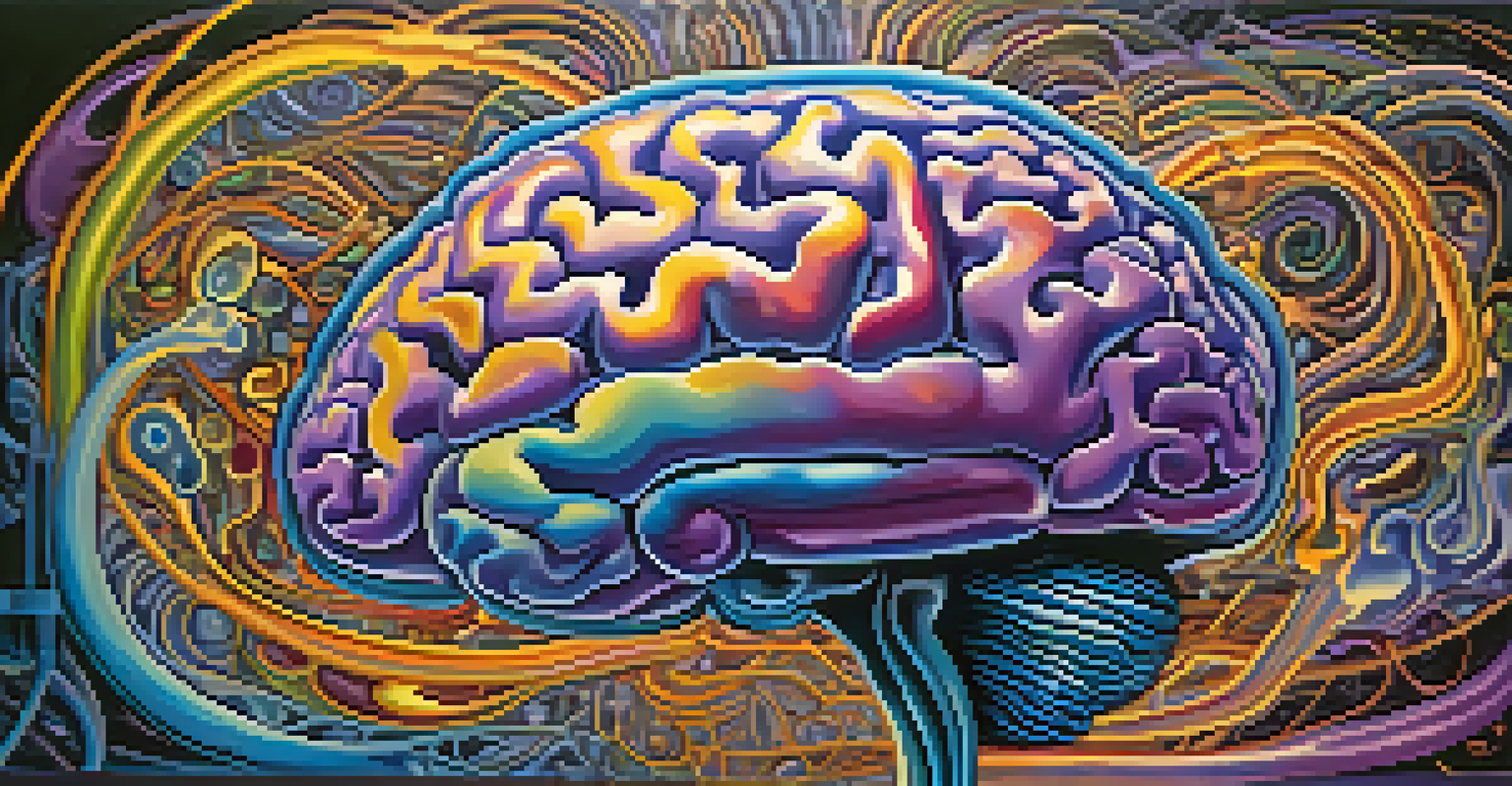Altered States of Consciousness: Definitions and Frameworks

Understanding Altered States of Consciousness
Altered states of consciousness (ASCs) refer to shifts in our normal perception of reality. These experiences can occur naturally, like daydreaming, or be induced through various means, such as meditation or psychoactive substances. Understanding ASCs is crucial as they impact our cognitive functions, emotional state, and overall experience of life.
We are not human beings having a spiritual experience; we are spiritual beings having a human experience.
In essence, ASCs can be viewed as a spectrum of consciousness, where individuals may find themselves in states that range from deep sleep to ecstatic experiences. Each state offers unique insights and understanding about the mind, often allowing for profound personal growth and exploration. This journey through different consciousness levels can help us better understand our own thought processes.
Furthermore, ASCs have been studied across various cultures and historical contexts, revealing their significance in spiritual and psychological practices. By examining these states, we can appreciate how they shape our perceptions and interactions with the world around us.
Types of Altered States of Consciousness
ASCs can be classified into several types, including meditative states, hypnotic states, and drug-induced states. Meditative states are often characterized by deep relaxation and heightened awareness, while hypnotic states involve focused attention and suggestibility. Drug-induced states, on the other hand, are achieved through the consumption of substances that alter brain chemistry.

Each type of ASC has its own unique characteristics and effects on the individual. For instance, meditation can lead to improved mental clarity and emotional stability, while hypnosis may help in pain management or breaking habits. Understanding these distinctions can help individuals choose the right approach to explore their consciousness.
Exploring ASCs Enhances Well-Being
Engaging with altered states of consciousness can lead to improved mental clarity, emotional healing, and increased creativity.
Interestingly, some cultures have long recognized the significance of ASCs, utilizing them in rituals and healing practices. This historical context shows us that altered states are not just modern phenomena; they are woven into the fabric of human experience across the globe.
Inducing Altered States: Techniques and Practices
There are various techniques to induce altered states of consciousness, including meditation, deep breathing, and rhythmic drumming. Meditation, for example, has been practiced for centuries and can lead to profound relaxation and insight. By focusing the mind and calming the body, individuals can access deeper levels of consciousness.
The mind is everything. What you think you become.
Another popular technique is breathwork, which involves controlling one’s breathing patterns to elevate awareness or evoke emotional release. This practice can lead to spontaneous states of ecstasy or deep introspection, depending on the individual’s intention. Rhythmic drumming, often used in shamanic practices, can also facilitate ASCs by entraining the brain to specific rhythms.
Overall, the choice of technique depends on personal preferences and goals. Whether seeking relaxation, self-discovery, or healing, experimenting with different methods can enhance one’s journey into altered states.
The Science Behind Altered States of Consciousness
Recent advancements in neuroscience have shed light on the mechanisms behind altered states of consciousness. Brain imaging studies reveal how different states activate various regions of the brain, leading to changes in perception, cognition, and emotional experience. This scientific approach demystifies ASCs, allowing us to better understand their impact on our mental health.
For instance, studies show that during meditation, there is increased activity in the prefrontal cortex, responsible for decision-making and self-awareness. Similarly, moments of peak experience, often associated with ASCs, exhibit unique brainwave patterns that differ from ordinary waking states. This fascinating interplay between brain function and consciousness highlights the complexity of human experience.
Cultural Views Shape ASCs Understanding
Different cultures interpret altered states in various ways, influencing their significance in spiritual and therapeutic practices.
Understanding the science behind ASCs can empower individuals to explore these states with a sense of safety and intention. By grounding our exploration in scientific knowledge, we can approach altered states as valuable tools for personal growth and healing.
Cultural Perspectives on Altered States of Consciousness
Different cultures have varied perceptions and practices surrounding altered states of consciousness. Indigenous cultures, for example, often view ASCs as spiritual journeys that connect individuals to the divine or ancestral spirits. These experiences are typically integrated into rituals and community practices, reinforcing their significance within the culture.
In contrast, Western societies may approach ASCs more clinically, focusing on their psychological and therapeutic benefits. This perspective has led to the development of various therapeutic modalities, such as psychodrama and guided imagery, which utilize altered states for healing and self-exploration. However, this clinical view can sometimes overlook the spiritual dimensions of ASCs.
By exploring these diverse cultural perspectives, we can appreciate the multifaceted nature of altered states and their roles in human existence. Understanding ASCs through different lenses enriches our overall comprehension and encourages a more holistic approach to consciousness.
Benefits of Exploring Altered States of Consciousness
Exploring altered states of consciousness can offer numerous benefits, including enhanced creativity, emotional healing, and improved mental clarity. Many artists and thinkers credit ASCs as a source of inspiration, allowing them to tap into deeper realms of imagination. This creative boost can lead to innovative ideas and solutions that may not emerge in ordinary states of mind.
Additionally, ASCs can facilitate emotional healing by providing insights into buried feelings and unresolved issues. Through practices such as meditation and breathwork, individuals often encounter transformative experiences that help release psychological blockages. This healing journey can pave the way for personal growth and a greater understanding of oneself.
Inducing ASCs Requires Caution
While exploring altered states can be beneficial, it's essential to approach these experiences safely and with clear intentions.
Moreover, engaging with ASCs can promote mindfulness and presence in everyday life. By learning to navigate different states of consciousness, individuals may develop greater awareness of their thoughts, emotions, and behaviors, leading to improved well-being and resilience.
Safety and Considerations in Exploring ASCs
While exploring altered states of consciousness can be enriching, it’s essential to approach these experiences with caution and awareness. Some techniques, such as certain forms of breathwork or the use of psychoactive substances, may pose risks if not practiced safely. It’s crucial to understand one's mental and physical health before engaging in these practices.
Additionally, having a supportive environment and clear intentions can significantly impact the experience. Whether practicing alone or in a group, cultivating safety and comfort allows individuals to explore ASCs more freely. Seeking guidance from experienced practitioners can also enhance the journey and provide valuable insights.

Ultimately, the key is to remain mindful and grounded during the exploration of altered states. By prioritizing safety, individuals can fully embrace the transformative potential of these experiences while minimizing potential challenges.